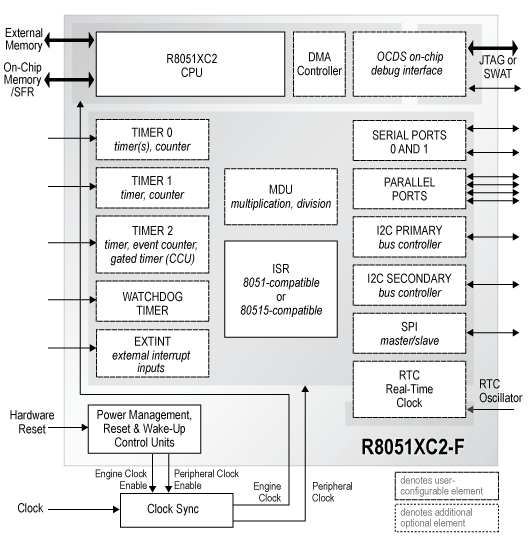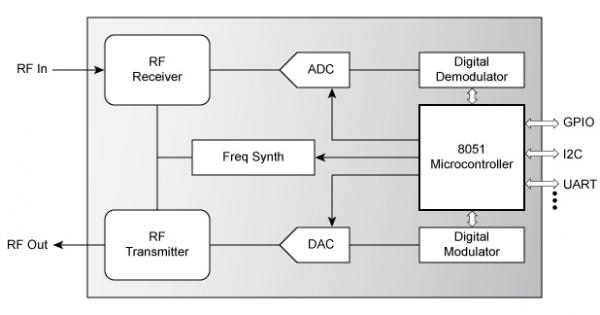Silicon IP Cores
8051s in the Spectrum of Microcontroller Choices
By Nikos, Zervas, Ph.D., VP Marketing for CAST, Inc.
Note: This article was also published by Chip Estimate and SoC Central.
There is a broader range of processor choices available to embedded systems and product designers today than ever before. At the higher end, some of the most exciting products use full 32-bit processors, such as the dual-ARM Cortex-A9s in Apple's iPad 2 A5 chip or the NVIDIA Tegra 2 in the Motorola Zoom and other Android tablets. Designers developing systems requiring slightly less processing power can choose from 32-bit microcontroller class devices such as the ARM Cortex-M0 or the BA22 available from CAST, Inc. And at the low end of the processor spectrum are 8-bit microcontrollers such as the venerable 80MC51 class devices.
But with many excellent low-power and sometimes cost-competitive 32-bit choices available, does the 8051 still have a role to play today? The answer is definitely "yes." For the right sorts of systems, 8-bit 8051 microcontrollers can still be a hero in today's mobile, feature-happy world.
8051s in the past
Intel introduced the MCS-51 single-chip microcontroller in 1980. The microcontroller's architecture integrated many critical functions in one compact package, including interfaces, memory, interrupts, and timers along with the core CPU.
Through the 1980s and 1990s, third-party vendors went on to offer several MCS-51 compatible variants. These often ran faster or included more functions than the original chip, and they served as the brains for a wide variety of successful products.
Today you can still purchase 8051s as discrete parts, but most designers license and use them as IP cores. Available in soft, high-level-language source code or firm FPGA-netlist formats, these cores are typically integrated within large embedded systems. But what would be some reasons for selecting an 8051 for an embedded system today?
Today's 8051 capabilities
Modern 8051 cores are faster and have more benefits than you might think. Details in the following examples are based on the 8051 IP family provided by CAST, Inc.
Architectural design improvements have significantly increased 8051 performance while retaining compatibility with the original MCS51 instruction set. The original Intel 8051 ran at 12 clock cycles per machine cycle, and most instructions were executed in one or two machine cycles. A typical maximum clock frequency of 12MHz meant these old 8051s could execute one million single-cycle instructions, or 500,000 two-cycle instructions, per second. In contrast, enhanced 8051 cores now run at one clock cycle per machine cycle, and have clock frequencies of up to 450MHz. That means 8051s can now execute 450 million instructions per cycle.
New, flexible 8051 cores are very capable. You certainly wouldn't constrain main system buses, memory connections, and other high-speed interfaces to just an 8-bit wide data path. But there are many command and control functions in advanced SOCs for which an 8-bit channel is more than adequate. Additions to the original's many built-in functions also boost the controller's capabilities, and a good configurable 8051 core makes it easy to include exactly what you need for a specific use (and no more). Figure 1 provides an example of the many functions and options available for an 8051 IP core.
8050 cores boast significant size and power consumption benefits. Even the lean 32-bit processors targeted at the embedded controller market, such as CAST's BA22 family or the ARM Cortex-M0, lose to 8051s when you examine their consumption of resources. The fully-featured version of the R8051XC2 core shown in Figure A requires just the same 12,0000 gates (in a TSMC 90-nm process ASIC) as a plain Cortex-M0. But by eliminating unneeded options and stepping down to a smaller core (the CAST T8051, for example), that area required drops to as low as 2,200 gates.
Modern 32-bit processors such as the BA22 employing reduced instruction sets and optimized memory access operations can actually use less power than some 8051s. However, 8051s can in some situations also offer comparable or somewhat less power usage than a 32-bit processor. For example, specs for the Cortex-M0 rate it at 0.085 mW/MHz (at 180nm), while the T8051 variant uses 0.081mW/MHz (also at 180nm).
In regard to cost, licenses for excellent, silicon-proven, 8051 IP cores are available for a few tens of thousands of dollars, and with no royalty whatsoever. No 32-bit processor licensing comes close to this low cost or attractive business model. Moreover, 8051s can run in very small FPGA devices, or occupy just a tiny fragment of a system-on-chip ASIC.
Finally, one of the biggest benefits to using an 8051 is the huge established ecosystem and programming heritage that make 8051 development easier than that for any other MCU. ARM's Keil group, for example, provides the excellent µVision IDE C51 tool set, with support for CAST and a huge number of other 8051 implementations. Complementing these tools are the complete packages and built-in debug capabilities from some IP vendors. For example, the complete EASE Debug Package from CAST includes an on-chip debug controller, a software plug in for use with Keil or Tasking development tools, and a standard JTAG hardware interface.
Overall, the array of integrated peripheral options, unique on-chip debug module, and documentation and support services polished through hundreds of previously successful 8051 customers make such an 8051 package a safe choice.
8051s remain suitable for many SOC applications
The conclusions about the 8051 market in a 2008 ARM-authored report "What is the 8051 Doing in the Year 2008?" still hold true today. 8051s are especially useful as:
|
RF connectivity systems — such as Zigbee, 2.4-GHz connectivity, and UHF transmitter/ receiver chips — are general examples of the latter, where an 8051 controls a digital modem and RxTx signals, and gives access to the system via UARTs, I2c, GPIO, or interrupts (see Figure 2).
IP subsystems now available make 8051s even easier to use for particular functions. For example, pre-integrated IP packages available from CAST and others make adding USB or Ethernet functions almost a plug-in process.
In summary
8051 microcontrollers no longer get the spotlight, but they're still used in products ranging from USB thumb drives to washing machines to complex wireless-communication SOCs.
Basic 32-bit processors such as the BA22 or ARM's Cortex-M0 are one way to go, but it's worth considering whether your system might be even smaller, use less power, and function just fine with any of the excellent 8051 IP core solutions available today.
About the Author
Dr. Nikos Zervas joined CAST, Inc. in 2010 and is the Vice President of Marketing. Before that, he was a co-founder, chairman, and CEO of video/ image SIP vendor Alma Technologies, SA. He is a board member of the Hellenic Silicon Industry Association, is a senior member of IEEE, and has published over forty papers in journals and international conferences.


